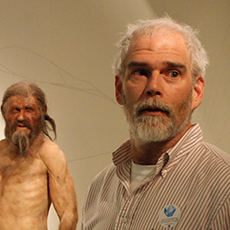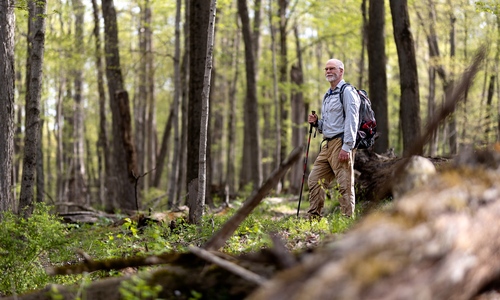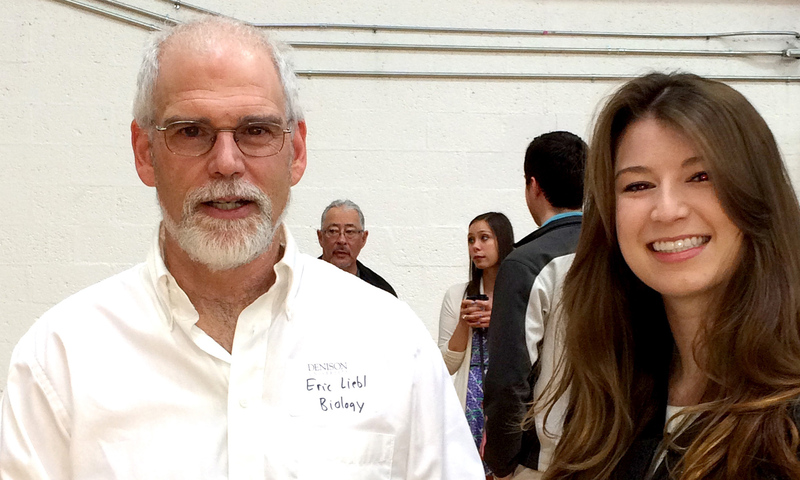Degree(s)
B.S., University of Wisconsin, Madison; Ph.D., University of California, Berkeley
Learning & Teaching
Academic Positions
- Professor, Department of Biology at Denison University, 2007 to present
- Chair, Department of Biology at Denison University, 2002 to 2007
- Associate Professor, Department of Biology at Denison University, 2000 to 2007
- Grant Reviewer, Developmental Neurobiology at National Science Foundation, 2001 and 2004
- External Reviewer for faculty promotions, ex. Department of Political Science at Pomona College (2007), Kalamazoo College (2001)
- Ad Hoc Manuscript Reviewer, ex. Department of Political Science at Genetics, Oncogene
- Student-Teacher Referee, Department of Education at Denison University, 2001
- Assistant Professor, Department of Biology at Denison University, 1994 - 2000
- Teaching Assistant, Department of Molecular and Cell Biology at University of CA-Berkeley
Research
In my lab, we use the fruit fly model system to study the development of sensory neurons. Currently, our focus is on genes that affect the neurons’ dendritic arbors, and how changing these complex structures impacts the neurons’ function.
Works
Publications
- Brown, HE, Desai, T, Murphy, AJ, Pancholi, H, Schmidt, ZW, Swahn, H, Liebl EC (2017). The function of Drosophila larval class IV dendritic arborization sensory neurons in the larval-pupal transition is separable from their function in mechanical nociception responses. PLoS ONE 12(9):e0184950.
- Dean, KE, Fields, A, Geer, MJ, King, EC, Lynch, BT, Manohar, RR, McCall, JR, Palozola, KC, Zhang, Y, Liebl, EC (2013). An Allele of Sequoia Dominantly Enhances a Trio Mutant Phenotype to Influence Drosophila Larval Behavior. PLoS ONE 8(12): e84149.
- Smith, JA and Liebl, EC (2006). Identification of the Molecular Lesions in Alleles of the Drosophila Abelson Tyrosine Kinase. Drosophila Information Service 88 20-23.
- Forsthoefel, DJ, Liebl, EC, Kolodziej, PA, Seeger, MA (2005). The Abelson tyrosine kinase, the Trio GEF, and Enabled interact with the Netrin receptor Frazzled in Drosophila. Development 132 1983-1994.
- Liebl, EC, Rowe, RG, Forsthoefel, DJ, Stammler AL, Schmidt, ER, Turski, M, Seeger, MA. (2003) Interactions between the secreted protein Amalgam, Amalgam’s transmembrane receptor Neurotactin and the Abelson tyrosine kinase affect axon pathfinding. Development 130 3217-3226.
- Liebl EC, DJ Forsthoefel, LS Franco, SH Sample, JE Hess, JA Cowger, MP Chandler, AM Shupert, Seeger, MA (2000) Dosage-sensitive, reciprocal genetic interactions between the Abl tyrosine kinase and the putative GEF trio reveal trio’s role in axon pathfinding. Neuron 26 107-118.
- Liebl EC (1999) Molecular Characterization of the Insertion Site in Eight P-Insertion Lines from the Kiss Collection. Drosophila Information Service 82 79-81.
- Liebl EC (1998) Testing for mutagens using fruit flies. The American Biology Teacher 60 1-5.
Presentations
- Liebl EC, H. Brown, H. Pancholi. Drosophila sensory neurons and the larval forager to wanderer transition. Society for Integrative and Comparative Biology Meeting in Portland OR, 1-16.
- Liebl EC. A dosage-sensitive genetic interaction between the Trio GEF and Sequoia transcription factor influences a Drosophila larval behavior. Given at the 73rd Annual Meeting of the Society for Developmental Biology, Seattle WA, 7-14
- Liebl EC, K.E. Dean, A.R. Fields, M. J Geer, E.C. King, B. T. Lynch, K.C. Palozola, E.M. Steenkiste, Y. Zhang. Characterizing M9.17, a strong dominant enhancer of the trio mutant phenotype. Given at the 71st Annual Meeting of the Society for Developmental Biology, Montreal Canada, 7-12
- Liebl EC, A.R. Fields, M. J Geer, L.J. Korbel, B. T. Lynch, K.C. Palozola. Characterizing M9.17, a strong dominant enhancer of the trio and abl mutant phenotypes. Given at the 53rd Annual Drosophila Research Conference, San Diego CA, 4-11
- Liebl EC, M. J Geer, B. T. Lynch, K.C. Palozola. Characterizing dominant enhancers of a trio mutant phenotype. Given at the 52nd Annual Drosophila Research Conference, Washington DC, 4-10
- Palozola KC, O. Uguru, K.E. Dean, R.R. Manohar, J.R. McCall, J.A. Smith and E.C. Liebl . Dissecting signal transduction networks involving the Abl tyrosine kinase and the Trio guanine nucleotide exchange factor. Given at the first annual McArdle Laboratory Research Symposium, Madison WI, 10-08.
- Liebl EC. Dosage-sensitive genetic interaction affecting axon guidance. Given to the University of Toledo Biology Department, Toledo OH, 2-08.
Other
Grants & Funding
- National Institutes of Health Academic Research Enhancement Award (AREA) Grant, “Understanding Trio and Abl in Drosophila Axon Guidance Through Genetic Modifiers” (PI; 1R15HD059924-01); $196,312; 8/2009 to 8/2012.
- National Science Foundation Grant, “Investigation of the integrated roles of Abl, Trio, and Neurotactin in axon outgrowth” (co-PI; NSF 0344053); $240,000 total award; $65,039 to Denison; 2004-2007
- National Science Foundation Grant, “Genetic and Cell Biological Characterization of Trio and Amalgam: Two New Enhancers of Abl” (co-PI; NSF 0990239); $341,752 total award; $218,716 to Denison; 2001-2004
- National Institutes of Health Academic Research Enhancement Award (AREA) Grant, “Probing Drosophila Abelson Tyrosine Kinase with Genetics” (PI); $98,182; 1996-2000.
Honors & Awards
- Richard Lucier Endowed Professorship in recognition of outstanding teaching and scholarship. August 2007 - present
- National Institutes of Health Academic Research Enhancement Award (AREA) Grant, “Understanding Trio and Abl in Drosophila Axon Guidance Through Genetic Modifiers” (PI; 1R15HD059924-01); $196,312; 8/2009 to 8/2012.
- Denison University Research Foundation Award, “A Systematic Search for Genetic Interactions Affecting Nervous System Development Involving the Abl Kinase and the Trio Guanine-Nucleotide-Exchange Factor”, $10,967, 2008-2009
- Participant in the Faculty Summer Institute on the Ethical, Legal and Social Implications of the Human Genonome Project sponsored by the Dartmouth College Institute for the Study of Applied and Professional Ethics. June, 2004 at Howard University, Washington D.C.
- National Science Foundation Grant, “Investigation of the integrated roles of Abl, Trio, and Neurotactin in axon outgrowth” (co-PI; NSF 0344053); $240,000; 2004-2007
- R. C. Good Fellowship, Denison University, 2001
- National Science Foundation Grant, “Genetic and Cell Biological Characterization of Trio and Amalgam: Two New Enhancers of Abl” (co-PI); $341,752; 2001-2004
- Andrew W. Mellon Foundation, Collaboration with Technology Grant (PI); $21,216 2000-2001
- Faculty Professional Development Award, Denison University, 2000
- Denison University Research Foundation Award, “Fine Mapping and Cloning of the Fruit Fly M109 Gene”, $3,534, 1999-2000
- Faculty Professional Development Award, Denison University, 1999
- Junior Faculty Fellowship, Denison University, 1998
- National Institutes of Health Academic Research Enhancement Award (AREA) Grant, “Probing Drosophila Abelson Tyrosine Kinase with Genetics” (PI); $98,182; 1996-2000.
- Faculty Professional Development Award, Denison University, 1995
- Damon Runyon-Walter Winchell Cancer Research Postdoctoral Fellowship, 1991-1994
- Outstanding Graduate Student Instructor, University of California, 1988
- National Science Foundation Graduate Fellowship Honorable Mention, 1987
- Regents Fellowship, University of California, 1986
- Honors Degree in Molecular Biology, University of Wisconsin, 1985
- Trewartha Honors Undergraduate Research Grant, University of Wisconsin, 1984
Student Collaborations
Senior Thesis Advised
- Impact of Hippo on the Morphology of Class IV Dendritic Arborization Neurons in Drosophila*. Zachary Schmidt, 2018.
- Nociception via Class IV Dendritic Arborization Neurons in Drosophila*. Allison Murphy, 2017.
- Investigating Gene-specific Impacts on the Forager-to-Wanderer Transition in Drosophila melanogaster. Trishna Desai, 2017.
- Investigating Dosage Sensitive Interactions Between trio, trc and fry in Drosophila melanogaster. Hannah Swahn, 2016.
- PNS-specific Rescue of a Larval Behavioral Mutant Phenotype Using the GAL4-UAS System. Hannah Brown, 2015.
- The Role of Biochemical Interactions Between the rhoGEF Trio and the Abl tyrosine kinase in Axon Guidance Pathways During CNS Development of Drosophila. Kelsey Elliott, 2015
- Observing Larval Nervous System Structure in Drosophila melanogaster Mutants Using GFP Fluorescence*. Harshida Pancholi, 2015
- Biochemical characterization of the Abl: Trio interaction. Kelsey Lecerf, 2013
- Mapping trio dominant enhancers on the second chromosome of Drosophila melanogaster*. Thomas Graf, 2013
- Biochemical characterization of the Abl: Trio interaction*. Bethany Klett, 2013
- Characterization of the molecular interactions between the sequoia and trio genes*. Yan Zhang, 2012
- Screening the second chromosome of Drosophila for dominant enhancers of the trio and abl mutant phenotypes*. Eric C. King, 2012
- Generating null alleles of PR2, a non-transmembrane tyrosine kinase that bings GTP-Rac. Lindsey Korbel, 2011
- Characterizing the Phenotype of SequoiaM9.17 Heterozygous, Trio Homozygous Mutants in the Drosophila CNS*. April Fields, 2011
- Molecular characterization of the 9.17 mutation in D. melanogaster: Identifying a dominant enhancer of trio. Bryan Lynch, 2010
- A study of novel genes that engage in dosage-sensitive interactions with the Trio family of proteins in Drosophila. Marcus Geer, 2010
- Mapping the M49 mutation in the genome of Drosophila melanogaster. Oby Uguru, 2009
- Locating dominant enhancers of the trio mutant phenotype in Drosophila melanogaster. Katherine C. Palozola, 2009
- Localizing dominant enhancers of the trio mutant phenotype and structure/function assays of Neurotactin. Kathryn Elizabeth Dean, 2007*
- Tyrosine phosphorylation of Trio by Abelson tyrosine kinase. Andrew Justin Bishop, 2007*
- An investigation of axon pathfinding in the central nervous system of Drosophila through the molecular and genetic characterization of dominant enhancers of the trio mutant phenotype. Jenna Susanne McCroskey, 2007*
- Investigating Neurotactin and localizing the dominant enhancers of the trio mutant phenotype. Rohan Raoul Manohar, 2006*
- Study on Neurotactin and dominant enhancers of the trio mutant phenotype. Lindsay Lee Bickel, 2006*
- Identification of protein:protein interactions of the intracellular domain of Neurotactin by biopanning of a phage display cDNA library. Timothy Ryan Heacock, 2004*
- Axon pathfinding in the central nervous system of D. melanogaster: Determining enhancers of the trio mutantphenotype from a random mutagenesis screen. Morgan Rebecca Koepke, 2004*
- Interactions with Nrt: A yeast two-hybrid assay. Brant Lloyd Eutzy, 2003*
- Amalgam and neurotactin are dosage-sensitive genetic modifiers of the Abl tyrosine kinase mutant phenotype. R. Grant Rowe, 2003*
- The development of the central nervous system of Drosophila melanogaster: Potential interactions with Trio and Neurotactin. Kara Beth Markham, 2001*
- Localization and characterization of the M109 mutation: A new allele of the Drosophila amalgam gene. Erica R. Schmidt, 2000*
- Isolation of enhancers of the trio mutant phenotype. Jay Korn, 2000
- Testing the effectiveness of two cryoprotectants (glycerol and ethylene glycol) and two freezing methods (dry ice block freezing and controlled rate freezing) in the cryopreservation of domestic felid spermatozoa. Katherine A. Beltaire, 1999*
- M89: Transposon mutagenesis and recombination with fax. Lara S. Franco, 1999
- Mycobacteriophage L5: Investigation of the integration complex and further characterization of the mIHF binding site. J. Michelle Kahlenberg, 1998*
- Generation and characterization of gamma-ray generated M89 alleles. Matthew P. Chandler, 1998
- Fine localization and characterization of the M89 gene in Drosophila melanogaster. Jon E. Hess, 1998*
- Deficiency and meiotic recombinant mapping of the Drosophila Abl interacting gene M109. N. Reid Perala, 1998*
- Genetic experiments exploring the Abl:Disabled genetic interaction. James Pavelka, 1997.
- The search for a suppressor of the enabled mutant phenotype. Jason A. Hoppe, 1997.
- The mapping and characterization of the M89 mutation in the genome of Drosophila melanogaster. Jennifer A. Cowger, 1997*
- Using Drosophila genetics to study signal transduction by the Abl tyrosine kinase. Susan C. Howard, 1996*
- The mapping and characterization of the M89 mutation in Drosophila. Angela M. Jackson, 1996*
- Detection of a polymorphic microsatellite in the 21-hydroxylase gene region of the horse. Jennifer J. Carlisle, 1995*
* Denotes an honors thesis


